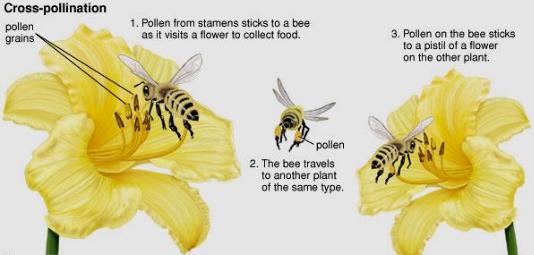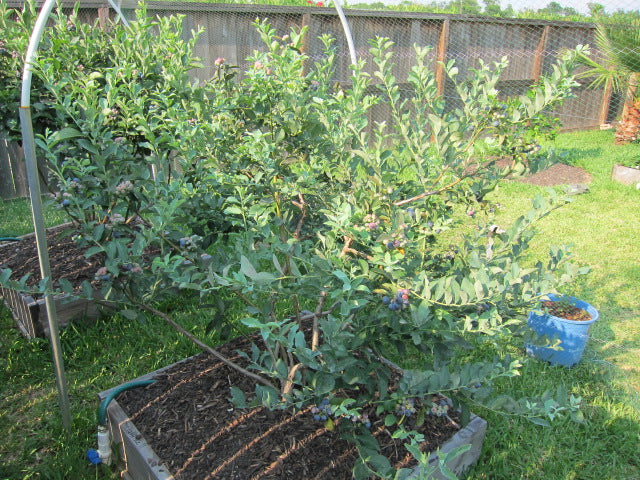Blueberry bushes are a great fruit bearing plant for beginner gardeners. These bushes are easy to maintain and even easier to grow. So the question is...where to start? Here we will discuss what is the best Blueberry Bush to buy and it's noteworthy qualities. This will help you determine which plant will be best for your landscaping needs. We will explain exactly what your plant needs for optimum fruit production and survival. Need some landscaping ideas for your blueberry bushes? We've got ya covered!
Rabbiteye Blueberry Varieties
 The Rabbiteye can be classified as a vigorously fruit bearing plant that is naturally heat tolerant. Because of its ability to tolerate heat and its susceptibility to cold climates, the Rabbiteye blueberry bush is well suited for planting in the Southeastern US. These
The Rabbiteye can be classified as a vigorously fruit bearing plant that is naturally heat tolerant. Because of its ability to tolerate heat and its susceptibility to cold climates, the Rabbiteye blueberry bush is well suited for planting in the Southeastern US. These
shrubs are drought tolerant, highly productive, disease, and insect resistant. They are easy to grow once established and make a great fruit bearing plant to grow.
The Tifblue Blueberry bush is an outstanding fruit bearing shrub. It is the most cold hardy blueberry bush in the rabbiteye family. Reaching a height and width of 6-8 feet, it has the potential to produce an abundance of blueberries. White blossoms are formed in mid to late March with the promise of ripe berries in Mid-June to late July. The foliage can be characterized by a glossy green texture and beautiful burgundy fall color. Tifblue blueberries are small to medium in size and are sweet-tart in flavor.
The Climax Blueberry bush is a very popular variety in the Rabbiteye blueberry family. It is a bush that produces early in the season with a high yield of large, dark blue berries in early June to mid-July. Blooming in February to early March, the Climax Blueberry bush will be covered in tiny white or pink flowers making it an excellent plant for not only fruit production, but as an attractive hedge as well. Generally growing to 6-8 ft. tall, the Climax blueberry bush can reach to an astounding size. Climax Blueberries are large and sweet in flavor with a firm but juicy texture.
The Premier Blueberry bush produces early in the season with a high yield of large, dark blue berries. Blooming in February to early March, the Premier will be covered in tiny white or pink flowers. Fruit arrives in Early June to late July. Premier blueberry bushes can grow to be 6-10ft high and 6-8ft wide. The berries produced are medium in size and sweet in flavor.
The Powderblue Blueberry bush gets its name from the powdery blue blush that the berries represent upon ripening. It is actually one of the toughest blueberry plants with a late ripening season. The Powder blue has an upright-growing habit that can reach a height and width of 8-12 ft. Flower blooms arrive in late spring with a harvest ready for picking in late summer. The blueberries are medium-sized, firm, and packed with juicy sweet flavor.
The Brightwell Blueberry bush has an upright-growing habit that produces foliage and fruit vigorously with a height that can reach up to 10 ft! Flowering starts in late spring to early summer. Fruit production is at its height in mid to late summer. It is a mid to late season harvesting blueberry variety, but you will not be displeased with the high yield results. Green foliage is prominent in the growing season, while fall gives way to a beautiful shade of red. The winter allows for plenty of peeping sunlight without the worry of frost damage.
Southern Highbush Blueberry Varieties
The Southern high bush blueberry plants were hybridized for their superior fruit, soil adaptability, and heat tolerance. Southern Highbush blueberries do not require a second plant because they are self-fertilizing. They are highly tolerant to heat and will also thrive in soils with low PH.
The Georgia Gem Blueberry bush is an excellent choice for a fruit bearing crop. It withstands high temperatures and does not require a second plant for cross-pollination. However, a second plant will promote a better fruit production. The Georgia Gem produces blooms in early spring, and will have ripe berries in early May to June. This bush will grow to be about 6-8 ft. tall and wide and will have dark green foliage.
Blueberry Plant Requirements
 Blueberry plants require acidic soil to grow and produce fruit. These plants will not perform well if the soil PH is above 5.5. If you are unsure about your soil’s PH level, it can be tested. You can either test the PH level of your soil with an at home PH level testing kit or reach out to your Local County Extension Service for a soil test at little to no cost. If the PH level of your soil is too high, it will need to be lowered. It can be lowered by adding granular sulfur to the soil. Till the sulfur into the soil about 3 months before you plan on planting your bush.
Blueberry plants require acidic soil to grow and produce fruit. These plants will not perform well if the soil PH is above 5.5. If you are unsure about your soil’s PH level, it can be tested. You can either test the PH level of your soil with an at home PH level testing kit or reach out to your Local County Extension Service for a soil test at little to no cost. If the PH level of your soil is too high, it will need to be lowered. It can be lowered by adding granular sulfur to the soil. Till the sulfur into the soil about 3 months before you plan on planting your bush.
If you would rather use an organic approach, use coffee grounds or acidic peat moss. To ensure that the acidic level of the soil is maintained around your blueberry bush, add peat moss, pine needles, and/or coffee grounds around the plant once a year.
Along with acidity, these plants also like well-drained soil. To test how well your soil will drain, dig a hole and fill it with water. If the hole is drained within a couple of hours, you have good soil drainage. If the water is still remaining in the hole after 24 hours, you have poor soil drainage. To help the soil drain better, sand can be tilled into the soil or a raised bed can be created.
Blueberry plants require full sun for optimum production. They will survive in partial sun, but only when shade is provided early in the morning or late in the day. 7-8 hours minimum amount of sunlight is recommended for a healthy blueberry bush.
The Importance of Blueberry Plant Pollination
 Southern Highbush plants are self-fertilizing, however Rabbiteye plants need a second plant in order to pollinate and produce fruit. Even if a blueberry bush is self-pollinating, a second bush will benefit both plants for a larger fruit production through cross-pollination. Cross-pollination refers to the spreading of pollen from one plant variety to another variety of the same species.
Southern Highbush plants are self-fertilizing, however Rabbiteye plants need a second plant in order to pollinate and produce fruit. Even if a blueberry bush is self-pollinating, a second bush will benefit both plants for a larger fruit production through cross-pollination. Cross-pollination refers to the spreading of pollen from one plant variety to another variety of the same species.
Blueberry bushes produce thousands of flowers every year, with each one having the potential to be a blueberry. In order for a blueberry plant to set fruit, the pollen produced by the flower’s anthers must reach the stigma. This will then cause a seed to develop inside the flower’s ovary. Because pollen is very sticky and heavy, it is not able to be easily moved and carried around by the wind.
Blueberry Plant Landscaping Ideas

Blueberry bushes look great when added to the landscaping. They not only produce enjoyable treats, but they provide multi seasonal interests. These shrubs display pretty bell-shaped flowers in the spring and a full crown of green foliage in the summer.
Early to late summer, you can expect ripening fruit ready for harvest and fall gracefully turns the green foliage to pinks, reds, yellows, and oranges. Blueberry bushes drop their leaves in the winter, adding additional sunlight peeping through the branches and providing a great window for pruning opportunities.
Blueberry bushes are easy to maintain, but do have specific requirements. If your native soil is naturally acidic, great! That means less soil maintenance. If not, soil PH levels will need to maintained at an acidic state. If you are planting your blueberry bushes directly into the soil, they will look great as hedges or even planted as lone specimens.
Plant blueberry bushes 6 foot apart in rows for a beautiful fruit bearing hedge. Always remember to plant 2 or more blueberry bushes to allow for cross-pollination. If you do not like the idea of maintaining the soil on a regular basis, you can always build a raised bed or plant them in pots. Building a raised bed, allows you the ability to use a pre mixed soil that is naturally acidic and also helps out when trying to mow around you plants. Not enough room for a raised bed, just plant them in pots!
If you were wondering what is the best Blueberry Bush to buy, browse our online garden center for your favorite Blueberry bush options!
You May Also Like:

